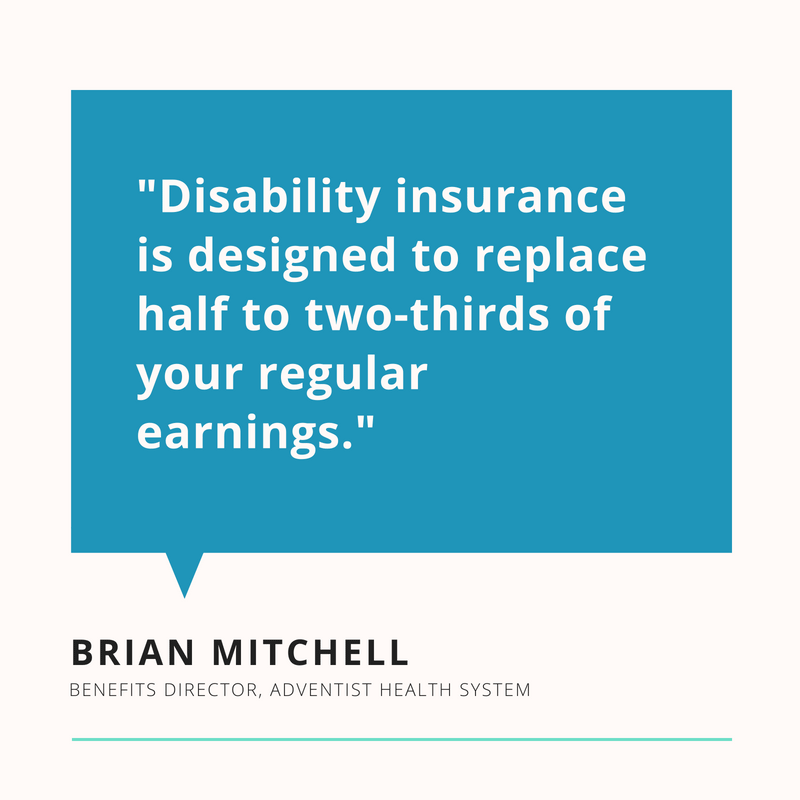In my previous post on benefits, we talked about life insurance as a gift for your family members. Disability is a gift for YOU and your family. In the same way life insurance helps replace your income stream for your family, disability insurance helps you maintain an income stream in the event you have an illness or injury that prevents you from being able to work.

Who Needs Disability Insurance?
What would happen if you were unable to work and bring home your regular paycheck for several months or years? If the answer is, “I couldn’t pay my bills or buy groceries,” then you need Disability Insurance. This benefit is designed to replace half to two-thirds of your regular earnings depending on the plan. There are several reasons why it only covers part of your earnings:
- If you’re not working, you’re probably not incurring as many expenses from things like commuting or dry cleaning.
- A percentage of your income usually goes to taxes, but depending on how your insurance premiums are paid, you may not need to pay taxes on the disability payments you receive.
- Your employer and the disability insurance carrier want to make sure you’re motivated to recover and return to work as quickly as possible. I’ve heard disability benefits described as a “safety net, not a hammock,” meaning that they should sustain you, but not become such a comfortable place that you want to hang out there for a long time.
Short-Term Disability Covers Periods of 13-26 Weeks
Short-term disability typically covers periods of 13 to 26 weeks. I know it may seem strange, but pregnancy falls into this category, so this is where maternity leave comes from. Short-term disability also kicks in when you have an accident, complicated illness, or other ailment that requires more than a few days away from work, but that you’ll probably recover from within a couple months.

Long-term Disability Can Range from Two Years to Retirement
Long-term disability picks up at the end of the short-term period and can provide benefits ranging from two years to retirement depending on the plan. Unfortunately, during this longer period, your employer’s leave of absence policy could result in termination of your employment. But if you have long-term disability coverage, you will continue to receive those long-term disability benefits even after your employment has ended.
4 Things to Look for When Comparing Plans
There are four key variables to consider when comparing disability benefits from employers.
- Pre-existing conditions – Some employer policies exclude coverage for pre-existing conditions. For example, if you’ve already been diagnosed with a chronic health issue and are receiving treatment, you may not be eligible for disability benefits related to that condition for up to 12 months after transferring to a new employer’s disability plan. Pregnancy is one of the most common “pre-existing conditions.” In this case, you should consider taking out a personal disability policy, which we’ll talk about more in a moment.
- Benefit duration – How long is the period that the benefits are good for? As we discussed earlier in the article, this can range from a few weeks to the rest of your life, so make sure you’re clear on the terms.

- Benefit amount – If you end up needing to use the benefit, how much money will it provide? This is usually expressed as a percentage of your regular wages. For example, it may pay out 60% of what you regularly earn during the period of your claim.
- Your contribution amount – Just like with health insurance, the amount of money you’re required to put into the plan in order to receive coverage varies. Typically, it’s determined based on the benefit amount and your level of risk. People who have a higher income that would need to be replaced in the case of an emergency, or who are older and therefore at higher risk of injury will have to pay more. Plans that provide a shorter duration or lower benefit percentage may also offer the option to “buy up” the coverage amount or the duration period.
Do You Need an Additional Personal Disability Policy?
Depending on the type of work you do, your family situation and financial responsibilities, it might be a good idea to consider taking out a policy to supplement what your employer provides. An individual policy can be attractive, especially if you are able to permanently lock in low rates while at a young and healthy age.

You may want to take out a personal policy if:
- You are planning on changing jobs and want to bridge your disability coverage until the new employer’s plan comes into effect. (There’s often a benefit-eligibility waiting period.)
- You want to make up for the 40% of lost income that your employer-provided disability benefit doesn’t cover
- You need extra income to make auto or home modifications in case you’re permanently disabled
- You need extra income in case you’re permanently disabled and need help caring for your children or performing household duties
- You want to be able to fund your retirement so you have something to live off once your long-term disability benefits have ended
Next Week: Extra Benefits
So far in this series, we’ve talked about the “Big 5” employee benefits: health insurance, retirement, time off, life insurance, and disability. In the next post, we’ll wrap up with a quick review of some of the other benefits employers provide, including dental, vision, and pet insurance. If there are any other benefit offerings you’d like to see covered, let me know in the comments below!



